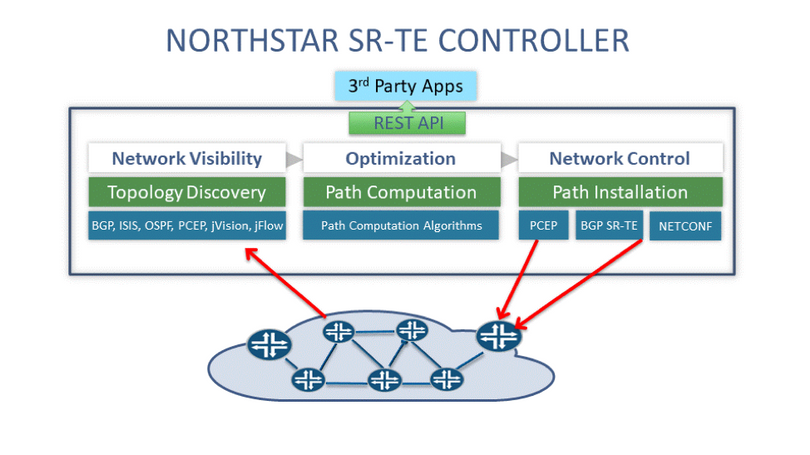Designing a network that provides optimal SLAs for its applications – bandwidth & latency guarantees, uptime and responsiveness – while reducing costs is a classic networking challenge. Historically, network planners have used sophisticated tools such as WANDL’s IP/MPLS View for capacity and scenario planning. Similarly, leading routing vendors have delivered real time end-to-end traffic engineering with built in CSPF (Constrained Shortest Path First) algorithms and RSVP-TE. These technologies have driven the growth of Internet and cloud applications by ensuring that cloud applications achieve desired network SLAs.
However, as cloud traffic continues to surge and new cloud services continue to go viral, network architectures must become simpler and more modular. New network architectures must allow more service customization and agility, while utilizing more cost effective routers/switches to transport ever increasing traffic economically. Most critically, network architectures must simplify operations.
Segment Routing (IETF name: SPRING) delivers network simplification by eliminating MPLS signaling protocols such as LDP and RSVP. It eliminates the hop-by-hop LSP path setup paradigm and allows the head-end router (or an application) to define the entire path for the application traffic by encoding path information in the packet itself. In this new SR paradigm, since the network contains no traffic engineering (TE) information, a Segment Routing (SR) controller is a must in order to ensure real time, end-to-end application level TE and SLA guarantees.
Enter the SR-TE Age with NorthStar SR Controller:
Today, routers compute the traffic engineered LSPs using distributed CSPF algorithms and configure them using RSVP-TE signaling.
In SR networks, however, path computation algorithms become centralized and move to controllers. SR controllers assume responsibility for traffic engineering the entire network. They express the TE path as a label stack in MPLS networks and as segment routing headers (SRH) in SRv6 networks. For their part, routers/switches simply forward traffic along the paths computed by the controller. To enable this architectural transformation, SR controllers must support rich, smart, adaptable traffic engineering algorithms, granular network visibility and, most critically, closed loop automated control to make real-time TE decisions based on real-time network conditions.
While many specific techniques of network control, visibility and traffic forwarding have evolved for the cloud era, core traffic engineering smarts – Juniper’s traditional strength – remain critical. The NorthStar SR Controller brings more than 20 years of traffic engineering leadership and deployment experience to the new SR era. Together, SR and the NorthStar SR Controller democratize TE and makes TE benefits available for all types of networks – from SP core and metro networks to cloud and enterprise networks.
Most critically, NorthStar also works with the existing routing infrastructure and helps graceful migration from current network operations to new SR operations.
Granular Real-Time Network Visibility:
Topology Visibility: It’s quite obvious that an SR controller needs real time network visibility in order to make real time decisions. In this critical aspect, NorthStar, with a built-in Junos engine, shines above the competition. NorthStar’s Junos engine communicates with the rest of the network with IGPs or BGP-LS, giving it exactly the same visibility into the state of the network as any other router in the network. When a network event happens – say a link goes down – NorthStar knows about the failure in real time and takes immediate corrective action. BGP-LS also provides NorthStar topology visibility into adjacent network domains, giving it a multi-domain topology visibility.
Network Visibility Beyond Topology: To ensure granular applications level SLAs in a network, topological visibility alone is not enough. For example, a 100G link may become degraded due to some device faults or link congestion. Although the link capacity still remains at 100G, it may not offer the required application experience. For more granular visibility into network performance, NorthStar implements the following technologies:
Streaming Telemetry: NorthStar subscribes to the streaming telemetry data sent by network elements. With streaming telemetry from all network elements, NorthStar has complete, granular visibility into the exact status of the entire network to make appropriate TE decisions. For example, if it detects excessive traffic drops in an LSP, it finds an alternate path through the network that bypasses the error prone path.
jFlow: NorthStar consumes jFlow records to understand network traffic patterns in real time and make TE decisions based on traffic patterns.
Synthetic Probes: Lastly, NorthStar consumes data from synthetic probes such as RPM (Realtime performance measurement) to understand the network performance from the perspective of an application packet traveling through the network. This perspective allows NorthStar to make TE decisions from an application’s perspective.
Traffic Engineering Algorithms Still Reign Supreme:
Ultimately, the primary purpose of an SR controller is to make real time traffic engineering decisions. Proven TE algorithms – deployed over last 20+ years – remain the crown jewels of NorthStar.
Juniper is making continued investments to enhance traffic engineering algorithms. For example, recently NorthStar added the capability to create P2MP LSPs to efficiently distribute multicast and broadcast traffic for real time video broadcast networks and financial services trading networks. Juniper is currently enhancing distributed CSPF with built-in support for multi-pathing to facilitate new scale-out architectures. These TE enhancements will be available on routers in distributed mode as well as on the NorthStar Controller in centralized mode.
In the future, when machine learning algorithms derive unique traffic engineering rules based on its learning of network utilization, time series analysis of traffic patterns using telemetry data, NorthStar will perform traffic engineering with unique, “machine learned” insights about that specific network.
Programmability: While NorthStar has a rich library of TE algorithms, Juniper’s goal is to empower customers to steer traffic based on their business needs. Towards that goal, NorthStar has published REST APIs that customer applications can use to steer traffic as per their business needs.
Smooth Architectural Transformation: NorthStar brings TE smarts to all deployments – SR and RSVP-TE – and allows coexistence of different network architectures and uninterrupted business operations, thereby enabling a smooth transition.
RSVP-TE to SR-TE migration is very interesting. During the transition, NorthStar creates a single TE database to allocate bandwidth to both RSVP-TE and SR LSPs. NorthStar also monitors traffic in both the network slices with granular streaming telemetry to ensure that traffic in each slice meets the requisite SLAs. This integrated TE database and monitoring makes transition hassle free. Similarly, NorthStar implements LDP monitoring to facilitate LDP to SR migration.
Diversity of Communication Channels between NorthStar and the network:
NorthStar helps SR-TE adoption in all network domains from metro to core to cloud to enterprises. It supports different protocols – popular for the deployments in different domains – to control the network.
NetConf: The simplest way for NorthStar to communicate the label stack that represents a SR LSP is using NetConf. This option allows operators to utilize the operational model they are most familiar with today.
Path Computation Element Communication Protocol (PCEP): Juniper was one of the early proponents of PCEP. It’s a robust signaling protocol that allows complete life-cycle managements – creation, monitoring and withdrawal – of LSPs from a controller. Additionally, PCEP collects statistics of all LSPs in a network – even if they are not created by the controller, thus giving it a complete view of all LSPs in a network. Juniper has extended PCEP to communicate SR label stacks, thereby leveraging the robust PCEP infrastructure for SR networks.
BGP SR-TE: For BGP SR-TE, Juniper has extended its robust BGP stack – on NorthStar as well as Junos – to configure SR LSPs. While BGP SR-TE by itself does not allow any visibility in the status of the created LSPs, with streaming telemetry, NorthStar gets complete visibility of these LSPs and creates a closed loop control between BGP SR-TE driven LSP configuration and streaming telemetry driven visibility in network utilization and events.

Cloud Era Business Transformation
While NorthStar’s technological innovations clearly bring simplicity, agility and continuity to network operations, it also helps customers align their business operations with cloud principles because it is a software product. NorthStar is deployed in a customer’s private cloud – or public cloud – thus simplifying planning, deployments and operations. Additionally, to align with cloud business models, customers subscribe to NorthStar software instead of purchasing it outright.
Network Transformation and Business Continuity Without Compromise
Ultimately, the great advantage of cloud era networking is architectural simplicity that enables service richness, agility and efficiency. Deploying NorthStar SR Controller provides a graceful migration from today’s deployments to modern traffic engineered SR architectures. Juniper brings decades of deployment experience to help you make the best network transformation plans based on your unique requirements and profit from the transformation.


